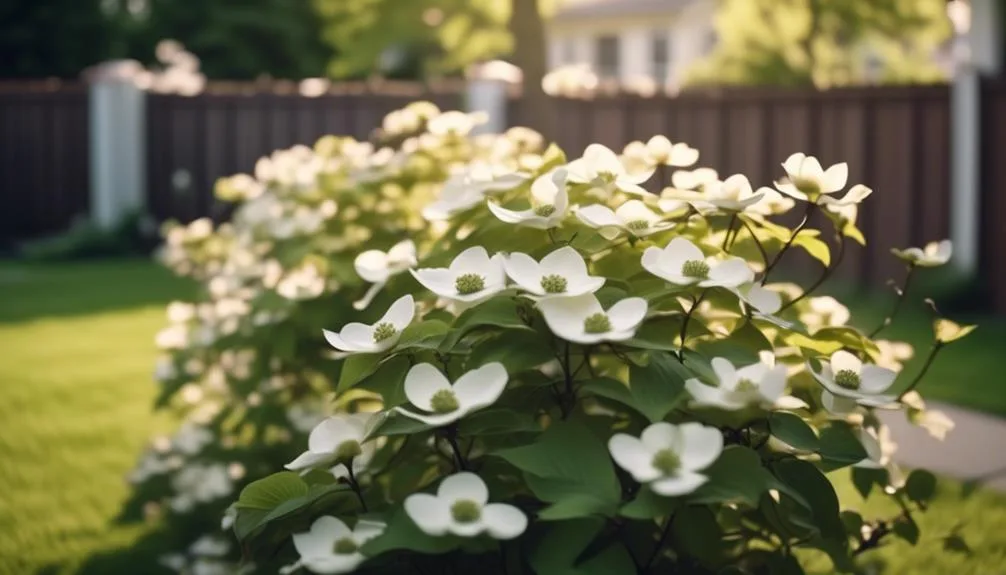Considering adding elegance to your small yard? Dogwood trees might be just the thing. They bring beautiful blooms and attractive foliage, and come in various sizes and shapes to fit your space.
However, before heading to the nursery, it's essential to weigh the pros and cons. Understanding their space requirements and potential challenges is crucial when deciding if dogwood trees are suitable for small yards.
Characteristics of Dogwood Trees
When considering dogwood trees for your small yard, it's important to understand their distinctive characteristics.
Dogwood trees are known for their beautiful flowering period, which typically occurs in the spring. They produce stunning clusters of flowers that can be white, pink, or red, adding a pop of color to your yard.
Additionally, dogwood trees have specific soil requirements. They prefer well-drained, acidic soil that's rich in organic matter. It's essential to ensure that the soil isn't too compacted, as this can hinder the tree's growth.
Space Requirements for Dogwood Trees
To ensure that your dogwood tree thrives in your small yard, it's important to consider its space requirements. Dogwood trees have a shallow root system that spreads horizontally, so they need ample space to grow without competing with other plants or structures.
When planting a dogwood tree in your small yard, ensure that it has enough room for its roots to spread out without being constrained.
Additionally, dogwood trees thrive in partial shade, making them suitable for smaller yards with limited sunlight. However, they still require some direct sunlight each day to bloom and grow properly.
When choosing a spot for your dogwood tree, consider the sunlight needs and ensure that it receives the right balance of shade and sunlight to flourish in your small yard.
Pruning and Maintenance Tips
For optimal growth and health of your dogwood tree in a small yard, regular pruning and maintenance are essential.
When it comes to pruning techniques, it's best to prune your dogwood tree during late fall or winter while it's dormant. Remove any dead, diseased, or crossing branches to improve air circulation and prevent the spread of diseases.
Additionally, you can lightly prune in the summer to maintain its shape and remove any unruly growth.
As for disease prevention and control, keep an eye out for signs of common dogwood diseases such as powdery mildew and spot anthracnose. Ensure good air circulation, avoid overhead watering, and promptly remove and destroy any infected plant parts to prevent the spread of diseases.
These practices will help keep your dogwood tree healthy and thriving in your small yard.
Best Varieties for Small Yards
Selecting the right dogwood tree variety is crucial for maximizing space and adding visual appeal to your small yard. When choosing a dogwood for a small yard, consider soil conditions and the flowering season.
For compact spaces, consider the Stellar Pink or Cherokee Brave varieties, which thrive in well-drained soil and bloom in early spring. If your yard has acidic soil, the Venus variety is a great choice, with its compact size and stunning white blooms.
For those seeking year-round interest, the Ivory Halo variety is a perfect fit, offering variegated leaves and white flowers in spring. These varieties not only accommodate small yards but also provide a burst of color and beauty during their blooming season.
Keep these factors in mind to ensure your dogwood tree thrives in your limited space.
Potential Challenges for Small Yards
If you're aiming to cultivate a flourishing dogwood tree in your small yard, navigating potential challenges becomes essential for its success.
One challenge to consider is the root system of dogwood trees. Their roots are shallow and can spread quite wide, which may pose difficulties in a limited space. You'll need to plan for potential root encroachment on nearby structures or other plants.
Additionally, while dogwood trees are known for their beautiful blooms, they do require a good amount of sunlight to thrive. In a small yard with limited sun exposure, providing adequate light for the tree could be a challenge. Understanding the shade tolerance of the specific dogwood variety you choose is crucial.
Careful planning and maintenance will be necessary to ensure the tree's root system and sunlight needs are met in a small yard.
Conclusion
In small yards, dogwood trees can thrive with their compact size, vibrant flowers, and minimal maintenance. Choose the right variety for your climate, and with proper care, they can bring color and beauty to limited spaces.
Consider potential challenges like pests and diseases, and with attention, dogwood trees can flourish and enhance small yards, adding natural charm to outdoor areas.

My interest in trees started when I first saw the giant sequoias in Yosemite.
I was a teenager then, and I remember thinking, “I need to learn more about this.”
That moment stuck with me.
A few years later, I went on to study forestry at Michigan Tech.
Since graduating, I’ve worked in a mix of hands-on tree care and community education.
I’ve spent over ten years helping people understand how to plant, maintain, and protect the trees in their neighborhoods.
I don’t see trees as just part of the landscape.
They are living things that make a real difference in our daily lives.
